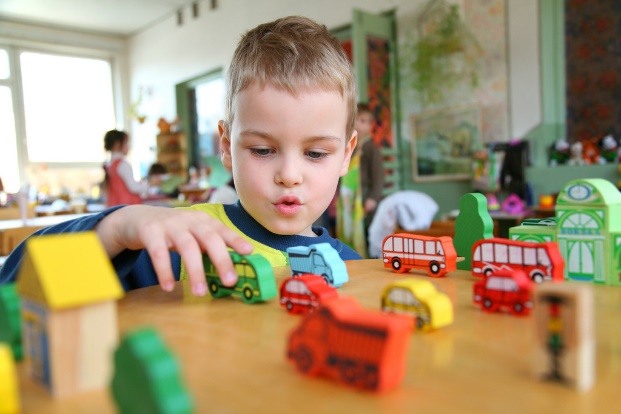Be Sure Your Kids Are Playing!
December 12, 2017
“Just go play!” “Why don’t you play with your toys?” “Let the baby just play with a toy for a while.” If you’ve ever said any of these things, good for you! From the time a child is born, throughout his/her childhood, play is an important—and necessary—component of development. We’ve put together some play pointers to further elaborate on the ages and stages of play and why it is so important.
Why is play important?
Babies play at every stage of development. Infants learn about how the world works by looking at their own hands, grabbing rattles or hitting objects. Toddlers use play more creatively. Encouraging more complex play helps children with important thinking skills and with the social understanding of what they can do and how competent they are.
How do babies play differently than toddlers?
As soon as babies can grasp with their hands, they explore toys by putting them into their mouths. By 9 months, mouthing toys is not as much fun as banging, shaking, and dumping things. By age 1, babies are putting objects into containers, and they understand that pushing a button or pulling a string can make things happen. It’s exciting to watch how an 18-month-old uses objects to act out familiar activities like eating, drinking and telephoning. By age 2, children are able to use pretend objects in place of real ones. Learning how to pretend is the beginning of dramatic play and is an important first step in learning how to play pretend games with other children.
What are the usual stages of children’s play?
Solitary play – this is the first kind of play where children play alone with their own toys or activities and do not try to make contact with nearby children. Examples include banging, shaking, filling and dumping.
Parallel play – children play independently but near each other. Examples include manipulating a doll to do common things, and doing a series of pretend activities, such as pouring and drinking pretend milk.
Associative play – children play with the same toy but not together. Examples include building separate structures with blocks or playing with play-doh without exchanging tools.
Cooperative play – Children play with the same toy together. Examples include board games or using Legos to build one structure.
What can I do to encourage play?
Babies need you to talk and sing to them and provide many kinds of toys and materials for them to explore. When the baby is tired and no longer want to play, it is time to stop. Toddlers need you to play with them in games they choose. You can help by giving suggestions; withdraw from the play when your child can handle the activities alone.
What toys and playthings are recommended?
For babies, it’s good to have toys that you and the baby can look at together. Talking about and playing with toes, fingers and body parts is just as wonderful as having rattles or soft animals to touch, chew on or shake. After the first few months of life, give toys that your child can use to make something happen, rather than just watch or listen to. A toy that pops back up when pushed over is better than a stuffed animal. For toddlers, manipulatives such as ring stackers and blocks are a great addition to cause-and-effect toys.
What is sensory exploratory play?
We all learn from our senses – from seeing, hearing, tasting, smelling and touching. We also learn from the sensation of movement. Your play—and your child’s—should include all of these sensations.
How can I help my child use the senses to explore and learn?
Birth to age 1 – Hang mobiles across the crib to provide new sights. Babies enjoy sound games as they approach their first birthdays. Hide musical toys so you child can locate them.
The 1-year-old explores by touching. In a special drawer, keep objects that are safe to touch and play with, such as a wooden spoon, funnel and old pan. A flashlight is another toy for this age. Sand and water play is fun too.
The 2-year-old touches and tastes everything, so keep electrical outlets protected and cords out of reach. He is able to match textures and likes to play “name that smell” game with soap, coffee and other familiar smells.
The 3-year-old is learning more about the world. Imitation is how they act out this understanding: they “bake” mud pies, “drive” a car, and “sweep” the floor. He enjoys blowing bubbles, splashing in water, and playing in sand.
The 4-year-old loves to run and chase, and to kick a ball. He loves to pretend to be someone else and enjoys dressing up. He can roll sections of play dough and form people.
The 5-year-old can climb up steps to a slide, ride a bicycle and use a monkey bar. He can learn to swim, skate, ski, dance and use a trampoline. He adds details to drawings, and may print his name.
Encourage play, play with your child(ren) and enjoy this very special part of childhood development!
If you have any questions or concerns about your child’s development, MKSA is here for you. Our caring professionals will answer your questions in confidence. You can reach us at 516-731-5588.
